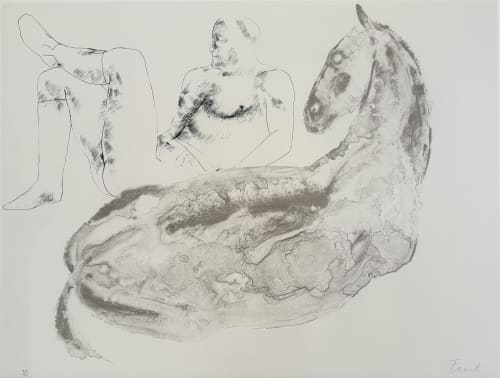Dame Elisabeth Jean Frink CH DBE RA (14 November 1930 - 18 April 1993) was an English sculptor and printmaker. Her Times obituary noted the three essential themes in her work as "the nature of Man; the 'horseness' of horses; and the divine in human form".
WW II, which broke out shortly before Frink's ninth birthday, and provided context for some of her earliest artistic works. Her early drawings, from the period before she attended art school in London, have a powerful apocalyptic flavour and themes including wounded birds and falling men.
Frink studied at the Guildford School of Art (1946-1949), under Willi Soukop, and at the Chelsea School of Art (1949-1953). She was part of a postwar group of British sculptors, known as the Geometry of Fear school, that included Reg Butler, Bernard Meadows, Kenneth Armitage and Eduardo Paolozzi. Frink's subject matter included men, birds, dogs, horses and religious motifs, but very seldom any female forms. Bird (1952 Tate, London), one of a number of bird sculptures, and her first successful pieces (also Three Heads and the Figurative Tradition) with its alert, menacing stance, characterises her early work.
Although she made many drawings and prints, she is best known for her bronze outdoor sculpture, which has a distinctive cut and worked surface. This is created by her adding plaster to an armature which she then worked back in with a chisel and surform plane. This process contradicts the very essence of "modelling form" established in the modelling tradition and defined by Rodin's handling of clay.
In the 1960s , Frink's continuing fascination with the human form was evident in a series of falling figures and winged men. While living in France from 1967 to 1970, she began a series of threatening, monumental male heads, known as the goggled heads. On returning to England, she focused on the male nude, barrel-chested, with mask-like features, attenuated limbs and a pitted surface, eg Running Man. Frink's sculpture, and her lithographs and etchings created as book illustrations, drew on archetypes expressing masculine strength, struggle and aggression. In 1984 she explained that she "focused on the male because to me he is a subtle combination of sensuality and strength with vulnerability".
The 1980s held highlights for Frink's career. In 1982, a new publishing firm proposed to produce a catalogue raisonne of all of her works to date and the
Royal Academy planned a retrospective of her life's work which was set for 1985. In this year alone, she was committed to two major projects: a set of three figures for a corporate headquarters, one of which was a nearly 7-foot- tall male nude; and the other, a grouping entitled Dorset Martyrs for Dorchester.
However, despite the potential for conflict, the retrospective was a success and spurred the art world to hold more exhibitions of Frink's work, with four solo exhibitions and several group ones coming in the following year. Frink continued to accept commissions and sculpt, as well as serve on advisory committees, meet art students and pursue other public commitments.
Having been elected a full Academician at the Royal Academy in 1979, there were moves to make Frink the first female President of the Academy. Frink however did not want the post and it went instead to Roger de Grey.
Frink kept up sculpting and exhibiting until early 1991, when an operation for cancer caused an enforced break. A few weeks later Frink was again creating sculptures and preparing for solo exhibitions. In September, she underwent further surgery. Frink did not let this hold her back, proceeding with a planned trip for exhibitions to New Orleans and New York. The exhibitions were a success, but Frink's health was deteriorating. Despite this, she was working on a vast statue, Risen Christ , for Liverpool Cathedral. This sculpture would prove to be her last; just one week after its installation, Frink died from cancer on 18 April 1993, aged 62, in Blandford Forum. Stephen Gardiner, Frink's official biographer, thought this last sculpture appropriate: "This awesome work, beautiful, clear and commanding, a vivid mirror-image of the artist's mind and spirit, created against fearful odds, was a perfect memorial for a remarkable great individual."
Frink married Michel Jammet in 1955 and had one child - the marriage was dissolved in 1963. From 1964 to 1974 she was married to Edward Pool, and in 1974 she married Alexander Csaky, who predeceased her by only a few months.
